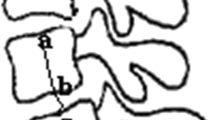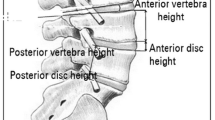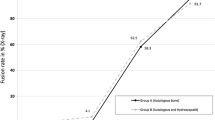Abstract
Purpose
The aim of this study was to compare the early efficacies of interbody fusion using autologous bone graft or an interbody fusion cage in a modified transforaminal lumbar interbody fusion (TLIF) in patients of different ages with degenerative lumbar instability.
Methods
Data from 33 patients with double-segment degenerative lumbar instability treated with a modified TLIF combined with a posterior fixation system from December 2008 to June 2014 were retrospectively analyzed. The two segments separately received an interbody bone graft fusion and an interbody fusion cage. Patients were divided by age into group A (middle-aged and elderly group, age ≥ 55 years, n = 13) and group B (young adult group, age < 55 years, n = 20). The clinical efficacy of the modified TLIF combined with a posterior fixation system was assessed using the Japanese Orthopaedic Association (JOA), Oswestry Disability Index (ODI), and Visual Analogue Scale (VAS) scores obtained before and after surgery, and at final follow-up. We measured the mean intervertebral space height, intervertebral foramen height, lumbar lordosis angle, and inter-technique differences in the mean intervertebral space height and intervertebral foramen height. Interbody fusion was evaluated using the Suk standard.
Results
Patients in group A followed-up for 19.15 ± 8.01 months. Patients in group B followed-up for 14.80 ± 5.47 months. The post-operative JOA, ODI, VAS, and lumbar lordosis angle were improved significantly. Moreover, the early clinical follow-up effect was good. In group A, significant differences in the intervertebral foramen height post-surgery and at final follow-up, and the mean intervertebral space height at final follow-up were noted. The intervertebral foramen and space heights were increased in the interbody cage group. In group B, a significant difference in the intervertebral foramen height at final follow-up was noted. The mean intervertebral space height post-surgery and at final follow-up was significantly increased between the two fusion methods. Bony fusion was achieved in all cases. The fusion time of autologous bone graft and interbody fusion cage was 5.46 ± 1.20 months and 6.77 ± 1.01 months respectively in group A, and 5.50 ± 1.28 months and 6.35 ± 1.76 months respectively in group B, the difference in fusion time between techniques was significant.
Conclusion
At different ages, the interbody fusion cages can better preserve the intervertebral space and the intervertebral foramen height. However, autologous bone graft can rapidly achieve a bony fusion. Interbody fusion cages are therefore ideal for young adults, while autologous bone grafting is ideal for middle-aged and elderly patients who receive a modified TLIF.

Similar content being viewed by others
References
Arnold PM, Robbins S, Paullus W, Faust S, Holt R, McGuire R (2009) Clinical outcomes of lumbar degenerative disc disease treated with posterior lumbar interbody fusion allograft spacer: a prospective, multicenter trial with 2-year follow-up. Am J Orthop (Belle Mead NJ) 38:E115–E122
Herkowitz HN, Sidhu KS (1995) Lumbar spine fusion in the treatment of degenerative conditions: current indications and recommendations. J Am Acad Orthop Surg 3:123–135
Burkus JK, Schuler TC, Gornet MF, Zdeblick TA (2004) Anterior lumbar interbody fusion for the management of chronic lower back pain: current strategies and concepts. Orthop Clin North Am 35:25–32
Kaiser MG, Haid RW Jr, Subach BR, Miller JS, Smith CD, Rodts GE Jr (2002) Comparison of the mini-open versus laparoscopic approach for anterior lumbar interbody fusion: a retrospective review. Neurosurgery 51:97–103
Cloward RB (1953) The treatment of ruptured lumbar intervertebral discs by vertebral body fusion. I. indications, operative technique, after care. J Neurosurg 10:154–168
Fujimori T, Le H, Schairer WW, Berven SH, Qamirani E, Hu SS (2015) Does transforaminal lumbar interbody fusion have advantages over posterolateral lumbar fusion for degenerative spondylolisthesis? Global Spine J 5:102–109
DiPaola CP, Molinari RW (2008) Posterior lumbar interbody fusion. J Am Acad Orthop Surg 16:130–139
Mehta VA, McGirt MJ, Garcés Ambrossi GL, Parker SL, Sciubba DM, Bydon A, Wolinsky JP, Gokaslan ZL, Witham TF (2011) Trans-foraminal versus posterior lumbar interbody fusion: comparison of surgical morbidity. Neurol Res 33:38–42
Stonecipher T, Wright S (1989) Posterior lumbar interbody fusion with facet-screw fixation. Spine (Phila Pa 1976) 14(4):468–471
Harms J, Rolinger H (1982) A one-stager procedure in operative treatment of spondylolistheses: dorsal traction-reposition and anterior fusion (author’s transl). Z Orthop Ihre Grenzgeb 120:343–347
Cole CD, McCall TD, Schmidt MH, Dailey AT (2009) Comparison of low back fusion techniques: transforaminal lumbar interbody fusion (TLIF) or posterior lumbar interbody fusion (PLIF) approaches. Curr Rev Musculoskelet Med 2:118–126
Lv FZ, Wang HL, Jiang JY, Ma X, Xia XL, Wang LX (2011) Mast Quadrant-assisted modified transforaminal lumbar interbody fusion. Chin J Orthopaed 31:1072–1077
Abdul QR, Qayum MS, Saradhi MV, Panigrahi MK, Sreedhar V (2011) Clinico-radiological profile of indirect neural decompression using cage or auto graft as interbody construct in posterior lumbar interbody fusion in spondylolisthesis: Which is better? J Craniovertebr Junct Spine 2:12–16
Zhang NN, Hao YH (2013) The investigation of bone mineral density on 1096 cases Han population in Daqing area and their incidence of osteoporosis. Chin J Osteop 19:1095–1098
Li CH, Ye W, Li JY, Huang DS, Liu SL, Zhang SL (2008) The effects of posterior fusion cage on stabilization in different segmental lumbar spine. Chin J Clin Anatomy 26:677–679
Dennis S, Watkins R, Landaker S, Dillin W, Springer D (1989) Comparison of disc space heights after anterior lumbar interbody fusion. Spine (Phila Pa 1976) 14:876–878
Liu Z, Liu J, Tan Y, He L, Long X, Yang D, Huang S, Shu Y (2014) A comparative study between local bone graft with a cage and with no cage in single posterior lumbar interbody fusion (PLIF): a multicenter study. Arch Orthop Trauma Surg 134:1051–1057
Miura Y, Imagama S, Yoda M, Mitsuguchi H, Kachi H (2003) Is local bone viable as a source of bone graft in posterior lumbar interbody fusion? Spine (Phila Pa 1976) 28(20):2386–2389
Suk SI, Lee CK, Kim WJ, Lee JH, Cho KJ, Kim HG (1997) Adding posterior lumbar interbody fusion to pedicle screw fixation and posterolateral fusion after decompression in spondylolytic spondylolisthesis. Spine (Phila Pa 1976) 22:210–219, discussion 219-220
Beutler WJ, Peppelman WC Jr (2003) Anterior lumbar fusion with paired BAK standard and paired BAK Proximity cages: subsidence incidence, subsidence factors, and clinical outcome. Spine J 3:289–293
Oxland TR, Lund T (2000) Biomechanics of stand-alone cages and cages in combination with posterior fixation: a literature review. Eur Spine J 9(Suppl 1):S95–S101
Kotil K, Ali Akçetin M, Savaş Y (2013) Clinical and radiologic outcomes of TLIF applications with or without pedicle screw: a double center prospective pilot comparative study. J Spinal Disord Tech 26:359–366
Ames CP, Acosta FL Jr, Chi J, Iyengar J, Muiru W, Acaroglu E, Puttlitz CM (2005) Biomechanical comparison of posterior lumbar interbody fusion and transforaminal lumbar interbody fusion performed at 1 and 2 levels. Spine (Phila Pa 1976) 30:E562–E566
Boden SD, Schimandle JH, Hutton WC (1995) An experimental lumbar intertransverse process spinal fusion model. radiographic, histologic, and biomechanical healing characteristics. Spine (Phila Pa 1976) 20:412–420
Brodke DS, Dick JC, Kunz DN, McCabe R, Zdeblick TA (1997) Posterior lumbar interbody fusion. a biomechanical comparison, including a new threaded cage. Spine (Phila Pa 1976) 22:26–31
Wang ST, Goel VK, Fu CY, Kubo S, Choi W, Liu CL, Chen TH (2006) Comparison of two interbody fusion cages for posterior lumbar interbody fusion in a cadaveric model. Int Orthop 30:299–304
Rihn JA, Kirkpatrick K, Albert TJ (2010) Graft options in posterolateral and posterior interbody lumbar fusion. Spine 35(17):1629–1639
Cutler AR, Siddiqui S, Mohan AL et al. (2006) Comparison of polyetheretherketone cages with femoral cortical bone allograft as a single-piece interbody spacer in transforaminal lumbar interbody fusion. J Neurosurg Spine 5(6):534–539
Zdeblick TA, Phillips FM (2003) Interbody cage devices. Spine 28(15):S2–S7
Weiner BK, Fraser RD (1998) Spine update lumbar interbody cages. Spine (Phila Pa 1976) 23:634–640
Patil SS, Rawall S, Nagad P, Shial B, Pawar U, Nene AM (2011) Outcome of single level instrumented posterior lumbar interbody fusion using corticocancellous laminectomy bone chips. Indian J Orthop 45:500–503
Song D, Chen Z, Song D et al. (2015) Comparison of posterior lumbar interbody fusion (PLIF) with autogenous bone chips and PLIF with cage for treatment of double-level isthmic spondylolisthesis. Clin Neurol Neurosurg 138:111–116
Hasegawa K, Abe M, Washio T, Hara T (2001) An experimental study on the interface strength between titanium mesh cage and vertebra in reference to vertebral bone mineral density. Spine 26(8):957–963
Acknowledgments
This study was supported by Anhui Provincial Natural Science Foundation (No.1408085MH184).
Author information
Authors and Affiliations
Corresponding author
Ethics declarations
Conflict of interest
None.
Additional information
Hua-zhang Zhong and Da-sheng Tian contributed equally to this work.
Rights and permissions
About this article
Cite this article
Zhong, Hz., Tian, Ds., Zhou, Y. et al. Comparing the early efficacies of autologous bone grafting and interbody fusion cages for treating degenerative lumbar instability in patients of different ages. International Orthopaedics (SICOT) 40, 1211–1218 (2016). https://doi.org/10.1007/s00264-016-3124-4
Received:
Accepted:
Published:
Issue Date:
DOI: https://doi.org/10.1007/s00264-016-3124-4




